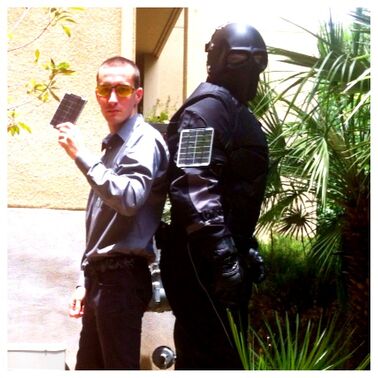
Real-life superhero Zimmer Barnes, left, models his bespoke Apollo solar charger, a tool to extend a smartphone's battery life, with colleague Nex. Photo: Zimmer Barnes
via WIRED :
Zimmer Barnes co-founder of the New York Initiative, a crimefighting troupe, recently cobbled together a wearable photovoltaic array designed to double an iPhone’s battery life. He calls it the Apollo. (Though it’s probably not a reference to the Authority character.)
And it’s not just for men and women in tights. “We talk a lot about energy independence from a national standpoint,” Barnes tells Danger Room. “This is a way for people to be independent for themselves from any kind of power grid.”
But make no mistake: The Apollo is a tool to assist the burgeoning field of masked vigilantes and protectors of the innocent. Barnes, a 24-year-old now based in Austin, Texas, explains that self-styled supes like himself often operate in places where accessing data from smartphones can be Kryptonite for their batteries — like, for instance, the tunnels where Barnes searches for homeless people in distress, or during a natural disaster. “Communications can be really bad in those situations,” he recounts.
The Apollo is already attracting interest from Barnes’ fellow heroes. “A smartphone is a superhero’s number-one crime fighting tool,” the Urban Avenger, a San Diego-based vigilante, tells Danger Room. “Police scanners, cameras, GPS and phoning the local dispatch can drain a phone fast. The Apollo solar panel arm band keeps my phone charged so I can keep doing my job.” At least until the Joker disables the cell towers.
Let’s get this out of the way: Yes, there are real superheroes; no, they do not have superpowers. The Initiative, with which Barnes is no longer affiliated, packs a non-lethal arsenal of throwing stars, stun guns and axe handles. Masks and codenames are optional — Barnes doesn’t use either. They converse, plan team-ups and talk shop on the internet, including on two forums that the Urban Avengermaintains. There’s a book and an HBO documentary exploring the phenomenon in depth.
Barnes built the Apollo after recently suffering a broken arm and attending a fabrication event in New York called the Open Hardware Summit in what he describes as a “big, giant, plastic, Borg-looking” brace. “I was surrounded by all these tech geeks and everyone had their own idea for how I should outfit it,” he says, like turning the brace into an outsized Swiss Army knife. He opted instead to hook on a solar panel, protected by a polycarbonate shield, connected to a battery and an iPhone dock. “A lot of people wanted to buy it and I got investors,” Barnes says.
That investor cash — now gone — went to turning Barnes’ prototype into a manufacturable product. The Apollo now uses a 6-volt solar panel, made by Voltaic Systems, a protective acrylic layer, and velcro arm straps. It’s a little bigger than a smartphone. (No, it won’t work at night.) It’s not iPhone-specific: Any phone or tablet with a USB port can charge through the panel. Barnes is thinking of retailing the Apollo for between $128 and $168, and he may be the first superhero with a Kickstarter page. Bruce Wayne or Tony Stark, he’s not.
But he does have something else in common with them. The Apollo isn’t the first superhero tool Barnes invented. That would be the North Star, a dazzler “to blind an attacker to get an edge in a fight.” The Apollo doesn’t have an offensive component — which helps explain one of the differences between fictional and real-life superheroes.
Some real-life superheroes really do fight thugs. Barnes recounts patrolling Austin’s rowdy Sixth Street after last call and breaking up drunken brawls. But mostly, real-life superheroes perform civic-minded services like painting over gang graffiti, helping the homeless and, in Barnes’ case, protecting Zuccotti Park during Occupy Wall Street. Out in Portland, Oregon, the adventurer known as Knight Owl is training to be a paramedic.
Knight Owl has known Barnes for years, and hung out with the New York Initiative during the 2010 New York Comic Con. He’s looking forward to using the Apollo.
“My phone has an encyclopedia of apps for EMS, Fire, Haz-mat, as well as the several dozen related podcasts I subscribe to which help augment my training,” Knight Owl says in an email to Danger Room. “Not having that useful data available in the event of an emergency could be catastrophic.”